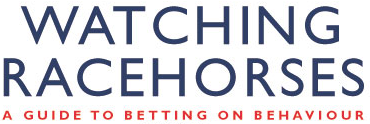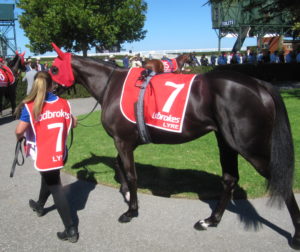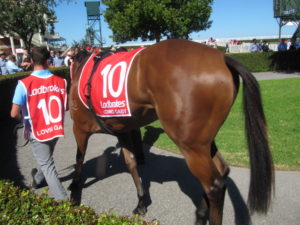The Blue Diamond – the Melbourne Cup for two-year-olds. Out the back I was immediately smitten by the Godolphin horses, and Lyre in particular, looking very relaxed alongside the stable pony. In the parade ring she looked terrific, bright red ear muffs, and salivating furiously, a positive as we know. Not big, and by comparison with the back side of the strong-looking favourite Loving Gaby, positively tiny. But the course announcer said the fave had a vet check, never a good sign. And a cross-over noseband.
- Lyre
- Loving Gaby
In the yard I scored Loving Gaby as changing stride, two strappers and dumping. Lyre was a head-in horse, still dripping saliva, and clearly superior. I went and backed it straight away. The horse came from last to first to run over the top of them. $2.60 for the place!





Geoffrey, on the subject of head behaviours I saw a horse the other day perform a rather rapid nose shake, in the vertical plan, that lasted a couple of seconds whilst in the mounting yard. It was a cold day so I can’t imagine it was caused by insects. Is there an explanation?
If it was in Melbourne where it was 38 at Flemington yesterday I’d suggest pollen. In the UK maybe a snowflake?
Thanks Geoffrey, so whatever the irritation it’s not something to worry about too much? It wasn’t a really cold day at Ascot(UK), around 8 to 10 degrees C, however some trees are flowering here so it could be pollen. Do horses suffer in the same way as human beings?
Geoff, can you clear something up for me? What is a “J-flared” tail. I see it is a negative sign in your tables in the book but you don’t clearly describe it in the text of your first book. I assume it indicates some degree of arousal which on the whole I think you regard as negative. In the text you refer to sideways swishing and go as far as saying it could be thought of as a flag tail. To me a flag tail is one raised 45 degrees or more off the rump with the hairs hanging down just like a flag. I regard it as quite a positive sign in male horses but much more common in females and thus less valuable from a punting perspective. However, if the female flicks the tail vertically up and down then it suddenly becomes positive in my eyes. My observations are usually made during the preliminary.
Hello Mark, I’m not sure if I can clear it up. There’s a pic of flared tail on p.145 of the first book. J-flared is simply if the tail is flared with the jockey up. It is often, but not always, a precursor to dumping. I think horses can get away with a dump when parading, if it is not too sloppy, but dumping when the jockey is up is not so good. I don’t attempt to distinguish up or down movement, but I do note swishing, which is generally side to side. I think I would be nervous with a female flicking the tail up and down. I think rotation of the tail is a bad sign, but I have no data.
I think I would worry as an irritated horse may not have its mind on the job. Do they suffer? I don’t know. I suffer!